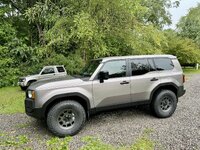- Jul 20, 2024
- 28
- Media
- 19
- 67
- Vehicles
- 2024 Toyota Landcruiser 1958, 1985 Toyota Landcruiser FJ60, 1998 Mitsubishi Pajero Mini, 1993 Jeep YJ, 2004 Mitsubishi Montero Limited, 2018 f150
I’ve been relying on the built in computer and my scan guage 3 to get an idea of mpg. I typically see between 22-24 on my scan guage which takes the tire difference into account vs 20-22 on the dash mpg guage. I am only ever seeing the number for that specific trip. Well I reset my meter and did a full tank and was blown away that it was actually much better than I expected. I went 360 miles on the dash which equals 392 when accounting for the tire change and used 15.063 gallons. That comes to 26 mpg! I was expecting closer to 20 because in my experience the dash gauges always seem higher than actual tank calculations.
I’m gonna do a few more tanks to make sure it wasn’t a fluke but at the moment I’m pretty happy. I’ve been wondering if the people complaining about super bad mpg aren’t calculating it correctly/have bad driving habits/ super heavy tires or all 3. I try to drive with the engine off as much as possible. I really wish I had more control over it because i know it is running more than it needs to. But overall I am pretty happy with that.
I’m gonna do a few more tanks to make sure it wasn’t a fluke but at the moment I’m pretty happy. I’ve been wondering if the people complaining about super bad mpg aren’t calculating it correctly/have bad driving habits/ super heavy tires or all 3. I try to drive with the engine off as much as possible. I really wish I had more control over it because i know it is running more than it needs to. But overall I am pretty happy with that.



